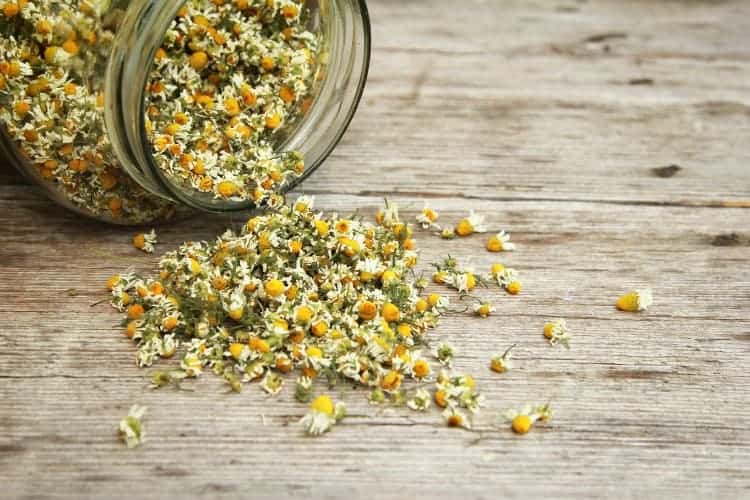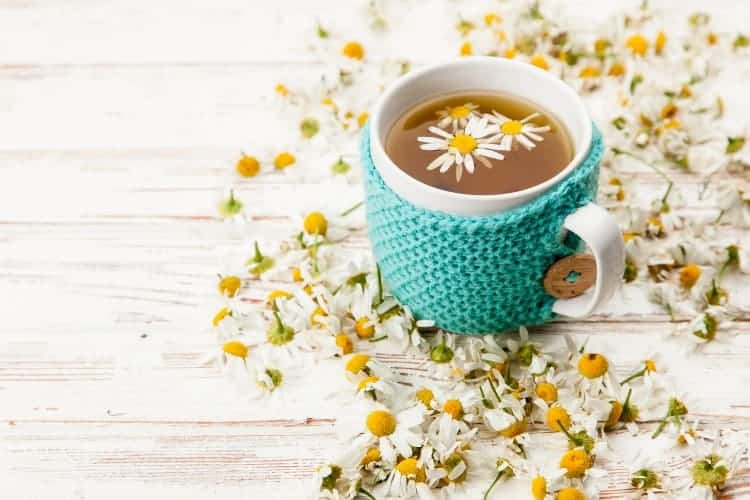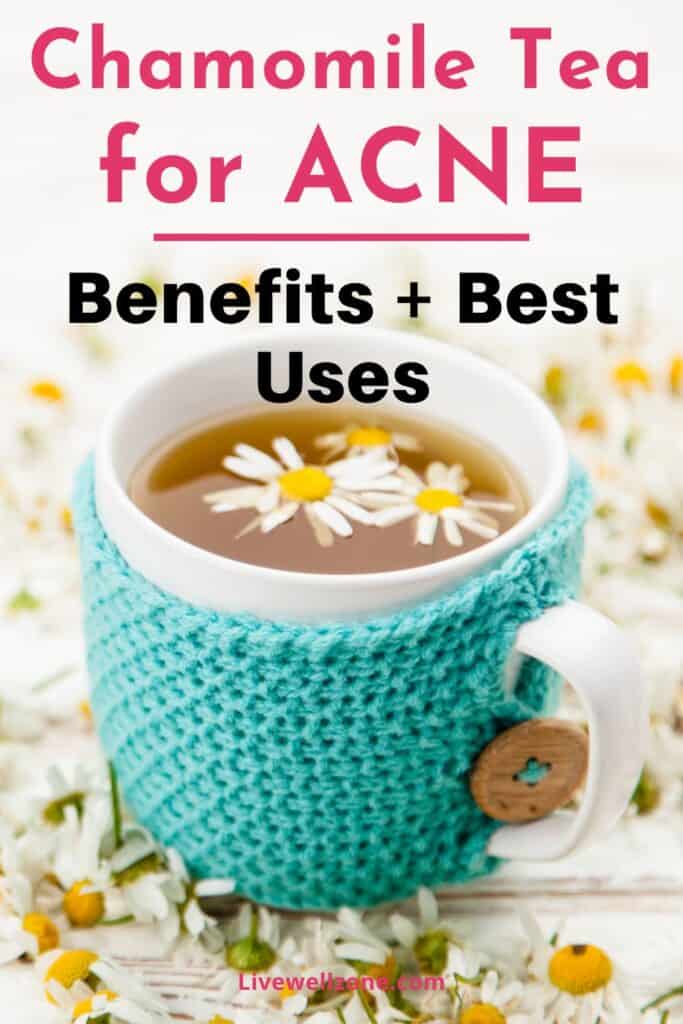
Chamomile is an herb that has historically been used for inflammatory conditions, including those that affect the skin. Now, since acne is also an inflammatory condition, this might lead you to wonder “is chamomile tea good for acne?” Here’s the quick answer:
Studies have shown that chamomile helps to fight the acne-causing bacterium p acnes, while also improving blood sugar and gut health (which are two major factors that contribute to acne). When used internally and topically, chamomile holds the potential to improve acne and skin health.
As you can see, even though chamomile is often seed as a “simple”, everyday herb, it also packs a punch, if used correctly.
So, if you’d like to learn more about how to use chamomile for blemish-free skin, then keep reading. In this post, we’re going to cover:
- how chamomile can improve the skin.
- which type of chamomile to use on the face.
- three ways to use chamomile tea on your skin.
BENEFITS OF CHAMOMILE TEA FOR ACNE-PRONE SKIN

Most of the information presented here comes from this medical review paper which covers chamomile’s traditional uses, as well as modern research on its benefits. Feel free to refer to check out the paper if you want to dig deeper into the details.
1. Regulates Blood Sugar
In a study done with 64 diabetic patients, those who drank chamomile tea with their meals had significantly lower blood sugar levels, compared to those who drank water (source).
Regulating blood sugar is an important aspect of improving acne because elevated blood sugar triggers inflammation.
And an increase in inflammation also means an increase in hormones that cause the sebaceous glands to produce more oil, ultimately making acne worse (source).
So, consider sipping on some chamomile tea throughout the day to help balance your blood sugar and skin.
2. Enhances Wound Healing
Some studies have shown that topical use of chamomile can actually speed up wound healing.
More specifically, chamomile speeds up the epithelialization process which occurs when epithelial cells in the skin move toward the top of the skin (in order to heal a wounded area).
This process is a must for repairing wounds.
This ability to speed up wound healing provides a clue as to why chamomile has historically been used for wounds, burns, bruises, eczema and other skin irritations.
Basically, what we’re seeing here is that chamomile has a history of soothing inflamed skin and this just might be beneficial for acne too.
3. Rich in Antioxidants
Chamomile contains a variety of antioxidants, such as flavonoids, which have been shown penetrate into the deeper layers of the skin.
This is yet another clue as to why chamomile has a history of being used topically.
In addition, studies show that flavonoids (source):
- can inhibit enzymes that are part of the inflammatory response. The inflammatory response system is a complex process that involves not only the immune system, but also hormone-producing glands like the adrenals (which makes cortisol, a hormone that can trigger excessive sebum production).
- influence the skin’s defense mechanisms and potentially regulate how the skin responds to environmental factors.
4. Supports The Gastrointestinal Tract (aka Gut)
Chamomile tea relaxes the digestive system and improves a variety of GI problems, such as diarrhea, ulcers, gas and colic.
Because there’s more and more evidence that gut health has a strong impact on acne (1, 2, 3), it’s important to address all signs of GI imbalance before they get worse.
And chamomile seems to be one herb that can play its part in supporting healthy function.
5. Natural Antibacterial and Astringent
Propionibacterium acnes is the bacterium that is often blamed for the development of progression of acne. And one study found that when comparing the antibacterial activity of plants against that bacterium, extracts from chamomile were the most effective (as are extracts from rosemary and the gum arabic tree).
In addition, chamomile acts as a natural astringent, meaning that it can tighten, dry or constrict tissue.
This action is mainly due to compounds known as tannins, which are found in herbal teas like chamomile (4, 5).
So, chamomile tea can basically be used as a DIY astringent to help shrink pores and dry up pimples.
Do keep in mind that as far as herbs go, chamomile is a mild astringent. However, this isn’t necessarily a bad thing because some stronger astringent can also have its drawbacks (such as more irritation, especially if your skin is very sensitive).
6. May Help To Fade Acne Scars
Because of its antioxidant content, chamomile may be beneficial for fading acne-related scars. This is because as a whole, antioxidants support skin regeneration. Or as one expert puts it:
“antioxidants are the foundation of skin rejuvenation.” – source.
Now, do keep in mind that since chamomile isn’t as strong as some other abrasive scar removal methods, patience is key when using it for this purpose.
Also, scars that cause indentations are generally more difficult to get rid of. So, you may need to use chamomile in combination with another remedy.
HOW TO USE CHAMOMILE TEA FOR ACNE: INTERNALLY AND ON FACE

When you’re ready to start using chamomile, the first thing to do is choose the right type. For the purposes of skincare, German and Roman chamomile are usually the go-to options (a third type of chamomile, known as Moroccan or Maroc, is less common)
Now, when it chamomile tea bags sold in grocery stores, these are usually made of the german variety. In some cases you might even see the latin name for german chamomile – matricaria recutita or matricaria chamomilla – in the ingredients list.
As for roman chamomile, it’s not usually available in regular grocery stores. However, you can get it from some specialty herb stores (locally or online).
1. Drink Daily As an Anti-Acne Tea
The basic recipe for making chamomile tea is:
- 1 tsp dried herb (1 tbsp fresh herb or 1 tea bag).
- 1 cup boiling water.
- Allow to steep for 10 – 15 minutes.
Personally, I like to aim for at least 2 cups a day when I’m using herbal tea as a natural remedy. But you can do more or less if you prefer.
Also, if you’d like a stronger tea, simply use more herb and/or allow the tea to steep for a longer period of time.
2. Mix with Oats to Make a Gentle Cleanser
If you have very sensitive skin and would like to try a gentle cleanser, this 3-ingredient cleanser just might be what you need.
Ingredients
1 tsp dried dried chamomile flowers (or 1 tea bag)
5 tablespoons old fashioned rolled oats (or oat flour)
1 cup of boiling water
Instructions
1. Prepare the chamomile tea using the standard ratio of 1 cup water boiling water to 1 tsp (or 1 tea bag) dried 2. chamomile. Allow the tea to cool down to room temperature (strain the herbs if using loose leaf tea).
2. If using rolled oats, grind them down to a fine powder using a blender or food processor. It should feel very soft when you’re done. Transfer to a bowl.
3. When the tea is cool enough, stir it into the oat powder until it makes a paste. If necessary, add more oat powder to reach the right consistency.
4. Wet your face and gently massage the cleanser all over your face (being careful to avoid the eyes).
5. Rinse with warm water.
6. This blend will keep for about a couple of days.
3. Use as a Natural Toner
Ingredients
1 cup water
1 tbsp dried chamomile flowers (about 2 or 3 tea bags depending on the brand)
Instructions
1. Bring the water to a boil in a small saucepan. Remove from heat and add in the chamomile.
2. Cover and allow to steep for 5 – 10 minutes.
3. Strain into a bowl or glass container. Allow to cool, then transfer to a spray bottle or a flip-cap bottle.
4. Spray onto face anytime you need a quick refresher or apply to a cotton pad and use it the same way you would use any other toner.
5. Store in the fridge and use within a few days (two to three).
NOTE: always do a patch test first to make sure you’re not allergic to chamomile, before you apply it to your entire face.
FAQs ABOUT CHAMOMILE AND PIMPLES
How long does it take chamomile tea to work on acne?
Even though there are no studies that focus specifically on chamomile’s effects on acne, there is research showing noticeable improvements in blood sugar levels after 8 weeks of consuming chamomile tea. However, there’s no knowing exactly how much of a reduction in pimples that would equate to.
Since chamomile tea is a natural remedy, how fast it works can be affected by:
- the quality of the herb you buy (I suggest organic, from a reliable source).
- how much systemic inflammation you’re experiencing.
- the quality of your diet and lifestyle.
- How long you’ve been struggling with acne and how severe it is.
If you choose to use chamomile tea internally, it’s a good idea to wait a few weeks to a month to see if you notice any changes.
CONCLUSION
As far as herbal remedies go, chamomile has a long track record of being used to address a long list of skin issues.
Now that modern science is investigating this herb, we’re starting to get more validation of chamomile’s antibacterial and anti-inflammatory properties. Not to mention the fact that preliminary studies show that chamomile balances blood sugar (a major acne trigger for some women).
Now that you’re armed with his information, I hope you feel more confident when it comes to deciding whether chamomile is for you or not.
And if you’d like more natural remedies that you can use to improve your skin, then check out the articles below!

You Might Also Enjoy:
10 Teas for Acne-Prone Skin (for internal and topical use)
A Comparative Guide to Green Tea vs Spearmint Tea for Acne
Spearmint Tea vs Spironolactone for Acne: Pros and Cons | Is One Better Than The Other?
Everything You Need To Know About Chamomile Tea vs Green Tea for Acne
10 Healthy Homemade Drinks for Clear Skin (that you need to know!)
Why Is My Skin Bad When I Eat Healthy? 8 Reasons You May Not Have Considered
Is Chamomile Oil Good For Acne?
Does Inflammation In the Body Cause Acne?
Seed Cycling for Acne: Benefits and How To Get Started
How To Make The Best Anti-Acne Smoothie To Give Your Skin New Life
What No One Is Telling You About Stevia and Acne
How Much Water Should I Drink To Get Rid Of Acne? The Answer May Surprise You
Green Tea vs Matcha for Skin: Similarities, Differences and How to Use Them for Clear Skin

